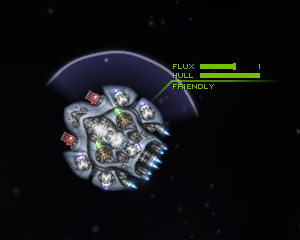Shield
Shields are the energy field raised around ships by right clicking. They act as the first line of defense for most ships.
General characteristics
Shields cost soft flux to keep running and generate flux when struck. The latter is usually hard flux, but beam weapons do soft flux damage, as do projectiles that have exceeded their maximum range and are fading out. The amount of flux generated is equal to the damage of the hit multiplied by the shield efficiency factor. Shields prevent dissipation of hard flux.
Generally, there is no way to break through shields without the shielding ship lowering its shield or striking the shield enough to force the ship to overload. A few weapons generate 'EMP arcs' that can penetrate shields.
Kinetic weapons do 200% damage to shields, high explosive weapons do 50% damage and fragmentation weapons do 25% damage. Shields negate EMP damage from shots.
Each ship class with a shield has a defined shield arc width, shield upkeep flux, and shield efficiency. When activated, the shield will gradually expand from zero width to its maximum size.
A higher Combat Readiness and the Hardened Shields hullmod give a bonus to shield efficiency. The Accelerated Shields hullmod increases shield rotation and expansion speed, and the Extended Shields hullmod increases the arc. The Field Modulation skill and the Flux Shunt hullmod allow slow dissipation of hard flux while the shields are up.
Fighters can get "under" a ship's shield (specifically, get into a position where their heading from the target ship's center is outside its shield arc) and damage its armor / hull directly. This is not possible if a ship has a 360° shield.
Shield Flux Modifiers
As mentioned earlier, things that contribute to the durability of shields such as Hardened Shields and high Combat Readiness apply their modifiers as consecutive complementary multipliers.
For example, consider the shield flux rating of the Fury, which is 0.7 by default. 100% combat readiness gives a 15% reduction, meaning the complementary multiplier will be 0.85. It has Hardened Shields too, giving it another 15% reduction - meaning another multiplier of 0.85. The captain also has Field Modulation, giving it another 15% reduction - thus yet another multiplier of 0.85.
So the final rating is 0.7 x 0.85 x 0.85 x 0.85 = 0.43.
Types
Shields are divided into two types: front shields, which are always centered on the front of the ship, and omni shields, which rotate with the mouse cursor. Generally, front shields have a wider arc, although the Paragon has a 360° omni shield. Front shields also expand twice as quickly.
The Shield Conversion - Front hullmod converts omni shields to front shields with a great bonus to shield arc and expansion speed, while the Shield Conversion - Omni hullmod has the opposite effect. The Extended Shields hullmod increases the arc by a small, flat value.
Ships without a shield or phase cloak can use the Makeshift Shield Generator hullmod to get front-facing shields.
Extending shield arc
Both Shields Conversion - Front and Extended Shields hullmods can greatly increase the shields' arc which is very desired on ships relying on their high shields values and flux management properties for achieving superiority in combat.
Ships with 180 degrees omni shields can have their shield converted to front, resulting in a full 360 degree shield. Conversion with this hullmod also gives a 50% reduction to shield upkeep, as well as faster shield movement and deployment.
Ships with 150 degrees omni shields can acquire a full surrounded shield as well with the additional help of the Extended Shield hullmod. In that case, the arc is first doubled by the conversion to a front shield, to a value of 300 degrees, and then the flat bonus of 60 degrees applies, thus completing the circle.
Ships with narrower arcs which have both of those modifications installed will have a narrow bottleneck weak spot in their six, with e.g. 120 degree omni shield ship having it be 60 degrees wide, and wider still for ships starting with narrower omni shields.
It goes without saying that applying such extensions can give a ship an edge in combat, whether it be by straightforward increase in survivability, further strengthening shield advantage or even opening up new tactical possibilities one can undertake.
Tactics
Where possible, selectively raise your shield to stop damaging high-explosive weapons (or to protect a damaged section of hull) and lower it against kinetic weapons. This is particularly important for omni shields, which typically have relatively high shield upkeep costs.
Keep your shield down when not in combat, as it prevents your ship from receiving the zero flux speed bonus.
When your omni shield is facing one direction, and a shot comes in from the opposite direction, it is often faster to lower your shield and re-raise it in the new direction rather than to turn the raised shield.
Shields will last 0.1 sec more after they are overloaded, so it is sometimes beneficial to stagger shots to ensure they punch through. This can be achieved with manual firing or using the alternating fire group mode.
- Potentially outdated
- Game concepts

